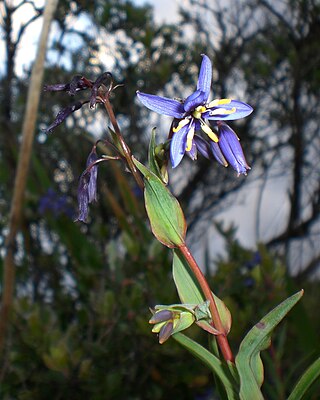
Pimelea spicata, commonly known as the spiked rice flower, is a flowering plant in the family Thymelaeaceae and is endemic to New South Wales. It is a slender plant with white flowers and elliptic leaves.

Acrotriche depressa, commonly known as wiry ground-berry or honeypots, is a flowering plant in the family Ericaceae. It is a small shrub with crowded greyish-green leaves and white or green flowers and grows in southern Australia.

Scaevola aemula, commonly known as the fairy fan-flower or common fan-flower, is a species of flowering plant in the family Goodeniaceae. It has mostly egg-shaped leaves and blue, mauve or white fan-shaped flowers. It grows in New South Wales, South Australia and Victoria.

Lobelia purpurascens, commonly known as white root or purplish pratia, is a flowering plant in the family Campanulaceae of eastern Australia. It is a small herbaceous, scrambling plant with white to pale pink flowers.

Stypandra glauca, commonly known as the nodding blue lily, is a flowering plant in the family Asphodelaceae. It is a rhizomatous perennial plant with blue lily-like flowers with yellow stamens. It is widespread across southern areas of Australia.

Prostanthera ovalifolia, commonly known as the oval-leaf mintbush or purple mintbush, is a species of flowering plant in the family Lamiaceae and is endemic to south-eastern continental Australia. It is an erect shrub with egg-shaped leaves and groups of mauve to deep blue-purple flowers arranged in groups at the ends of branchlets.

Acianthus fornicatus, commonly known as bristly mosquito orchid or pixie caps, is a species of flowering plant in the orchid family Orchidaceae and is endemic to eastern Australia. It is a terrestrial herb with a single, heart-shaped leaf and up to ten translucent pinkish-red flowers, and is widespread and common in coastal and near-coastal areas.

Westringia glabra, commonly known as violet westringia, is a flowering plant in the family Lamiaceae and is endemic to Australia. It is a small shrub with oval-shaped leaves and pinkish, mauve or purple flowers.

Solanum cinereum, commonly known as Narrawa burr, is a species of flowering plant in the family Solanaceae. It has dark green, spiny leaves and purple flowers and grows in open woodland in south eastern Australia.

Myoporum platycarpum, known by several common names including sugarwood, false sandalwood and ngural is a plant in the figwort family, Scrophulariaceae. It is rounded with bright green foliage as a young shrub and roughly fissured, dark grey bark when mature. Sugarwood is endemic to the southern half of continental Australia.

Pimelea glauca, commonly known as smooth riceflower, is a species of flowering plant in the family Thymelaeaceae and is endemic to eastern Australia. It has elliptic to more or less lance-shaped or linear leaves and creamy-white flowers arranged in heads of seven or more on the ends of the stems, with four lance-shaped to egg-shaped bracts at the base of the inflorescence.

Pimelea pauciflora, commonly known as poison rice-flower, is a species of shrub in the family Thymelaeaceae. It has small yellow-lime flowers and green, smooth fleshy leaves, and is endemic to Eastern Australia.

Caladenia minorata, commonly known as the small waxlip orchid, is a plant in the orchid family Orchidaceae and is endemic to eastern Australia. It is a ground orchid with a single very hairy leaf and one or two deep violet-blue flowers. It has been known as Glossodia minor since its description by the prolific Scottish botanist Robert Brown in 1810, but recent discoveries suggest its inclusion in the genus Caladenia. It is similar to Caladenia major but is smaller in all its parts.

Pterostylis revoluta, commonly known as the autumn greenhood, is a species of orchid endemic to south-eastern Australia. As with similar greenhoods, the flowering plants differ from those which are not flowering. The non-flowering plants have a rosette of leaves flat on the ground but the flowering plants have a single flower with leaves on the flowering spike. This greenhood has white and green flowers that have a long, curved, pointed labellum which extends beyond the sinus between the lateral sepals.

Thelymitra nuda, commonly known as the plain sun orchid is a species of orchid that is endemic to eastern Australia. It has a single fleshy, channelled leaf and up to twelve dark blue to purplish, sometimes white or pinkish flowers with white tufts on top of the anther. It grows in a range of habitats and sometimes forms large colonies.
Thelymitra angustifolia, commonly known as the long-leaved sun orchid is a species of orchid that is endemic to eastern Australia. It has a single erect, thin, channelled leaf and up to ten purplish blue flowers with white tufts on top of the anther. The flowers are self-pollinating.

Xyris gracilis, commonly known as slender yellow-eye, is a species of flowering plant in the family Xyridaceae and is endemic to eastern Australia. It is a tufted herb with linear leaves with 5 to 8 flowering stems with bright yellow flowers.

Prostanthera prunelloides is a species of flowering plant in the family Lamiaceae and is endemic to eastern New South Wales. It is a shrub with four-ridged branches, egg-shaped to round leaves and white or pale mauve flowers.

Conostylis serrulata, is a flowering plant in the family Haemodoraceae and is endemic to the south-west of Western Australia. It is a small perennial with yellow cream flowers and flat, green leaves.

Cynoglossum australe commonly known as Australian hound's tongue, is a flowering plant in the family Boraginaceae. It is a perennial herb with blue, pink or whitish flowers and found in most states of Australia.




















